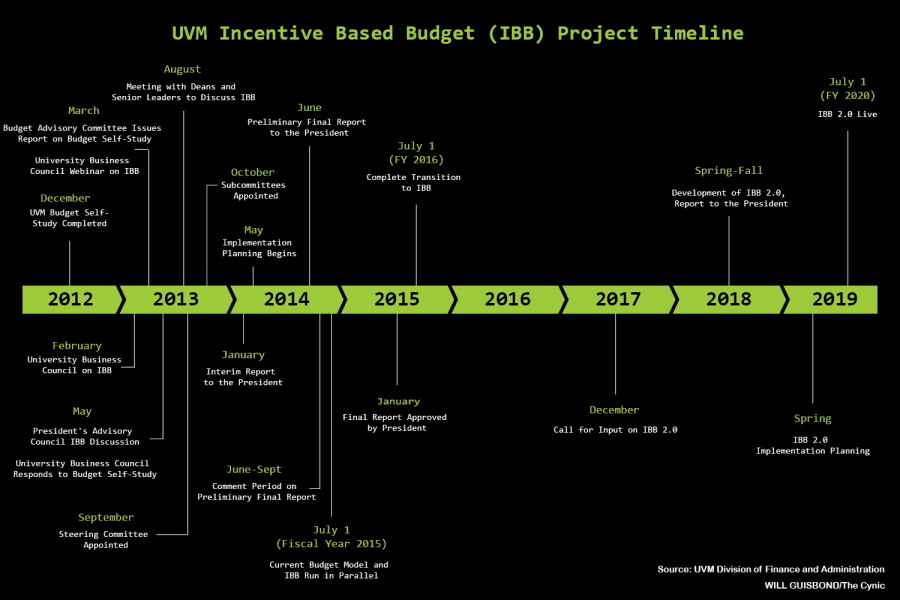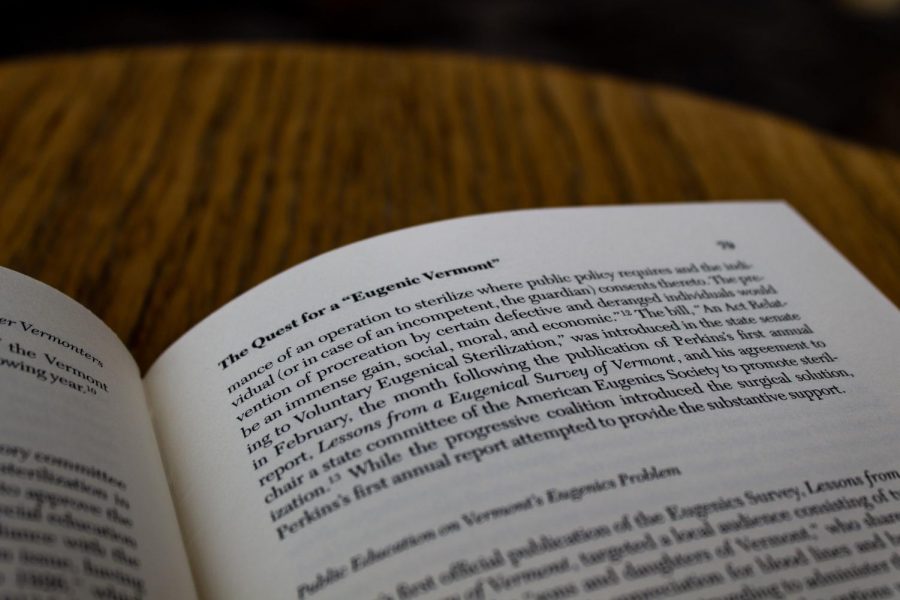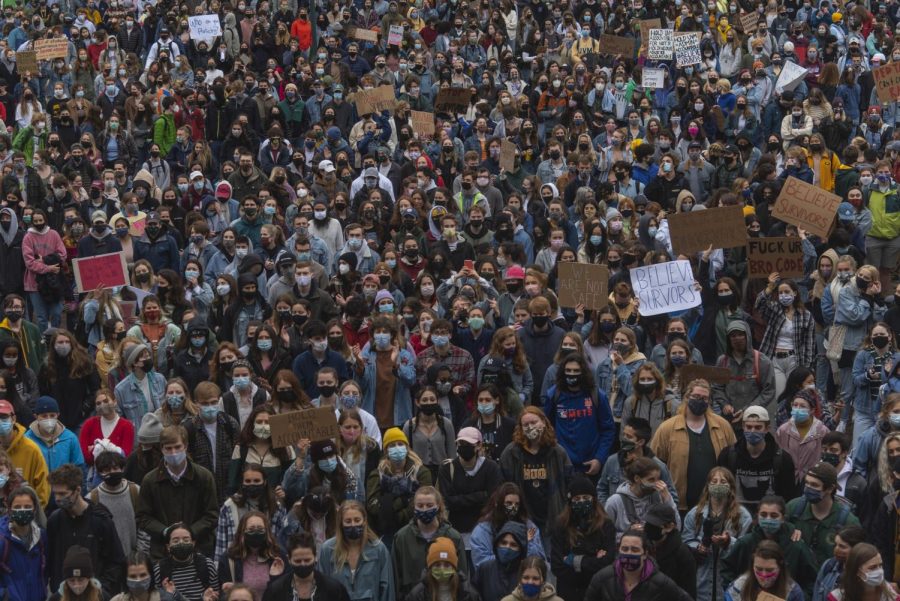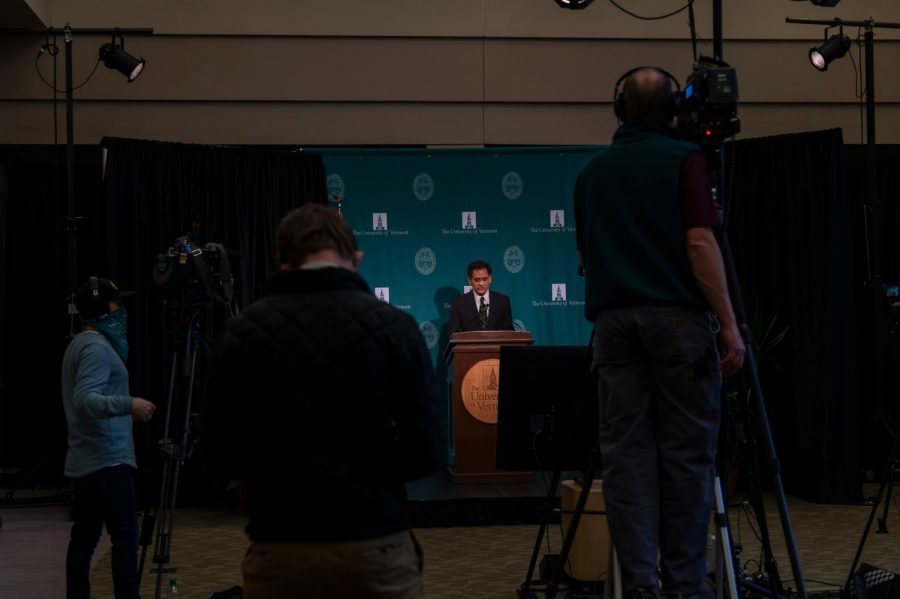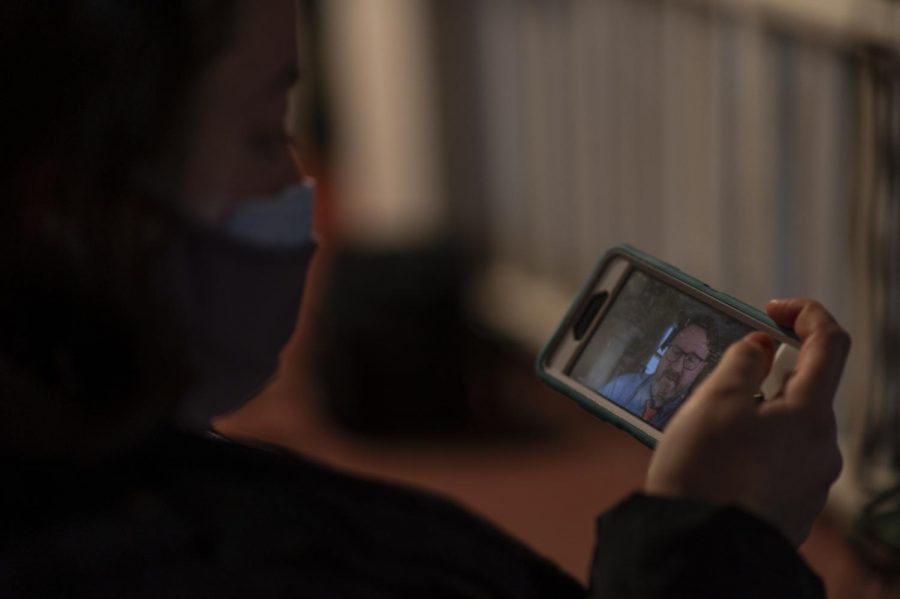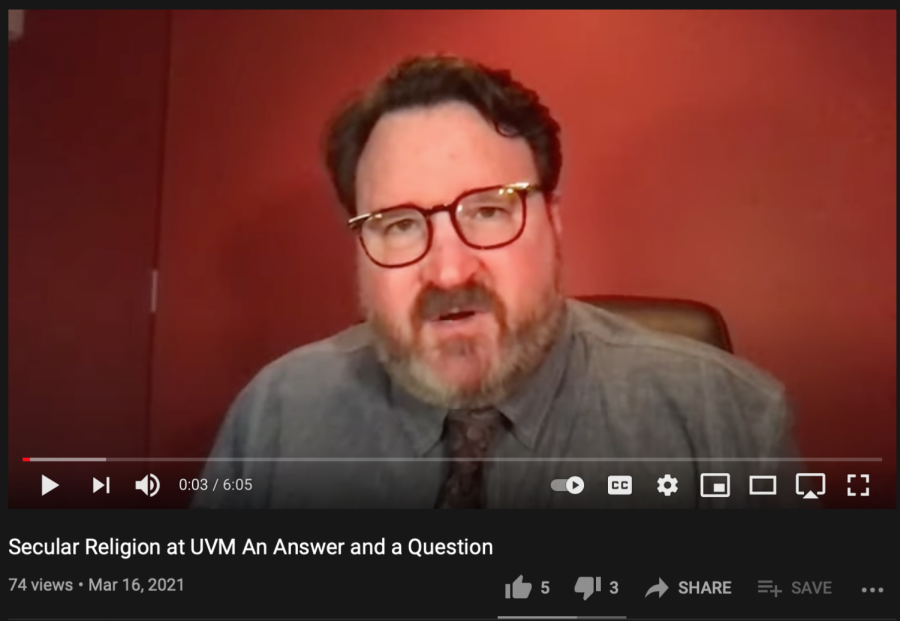The Feb. 27 presentation, “Blackface in the Past and in the Present,” by Wanda Heading-Grant and graduate as-sistant Jean Pak concluded a month widely known for its pronounced celebration of Black History, less widely known for the ghosts of history it harbors at UVM.
Cakewalk is a national tradition with roots in the Amer-ican slave South. After a day of inhumane labor, slaves would, on occasion, be made to entertain the master and his guests. The performer deemed most entertaining by the whites would “take the cake,” a lump of sugar or the like.
In the early 1800s white actor Thomas “Daddy” Rice traveled the country performing the song “Jump Jim Crow,” imitating slave dance and dialect and “blacking up” with burnt cork on his skin. Performances done in black-face would later be known as minstrelsy, the first form of popular American entertainment.
Minstrel troupes were not unlike modern bands as they toured the country (and Europe), bringing popular enter-tainment to the masses. The racial stereotypes of blacks portrayed in the minstrel shows would be severely in-grained on our nation’s culture. Just ask Aunt Jemima and Uncle Ben.
The period between 1883 and 1893 saw the most Black lynchings in U.S. history. 1893 is the year considered to be the first of Kake Walk at UVM.
By 1897, the enlarged event incorporated skits and dance in blackface and culminated in “Walkin’ fo’ de Kake” [sic]. The entire festivity was called “Kulled Koon’s Kake Walk,” a title used on and off throughout later decades with varying emphases on the three Ks.
By the 1960s, Kake Walk was the long-established cli-max of an entire weekend of festivities in February. Winter Weekend was primarily organized by campus fraternities and – to an extent, though limited by their sex – sorori-ties. The celebration was a regional tourist draw that is now incomparable and incomprehensible, driving up hotel rates and putting the fall foliage season to shame. Accord-ingly, local residents and students invested a lot of time and money into the production of Winter Weekend.
Above all, Kake Walk was a source of school and re-gional pride. Every February, The Cynic produced its most elegant issue of the year, which fronted a glossy cover, printed in color. Beginning in the mid 1950s, growing pressure from the students and faculties of UVM and St. Michael’s College, as well as the NAACP forced gradual reforms in the festivi-ties.
In an effort to salvage the doomed tradition, Kake Walk organizers made some concessions, such as switching the official color of the facial darkening agent, but in February of 1969, UVM Walked for the last time.
What Happened?SOARING SIXTIES USHERS IN A NEW ERA OF KAKE WALK The big event that UVM students have been looking forward to all year has finally come. During these Kake Walk holidays, all home-work and tests are forgotten as fraternity men and independents alike await the events of the weekend. The competition over ‘walk-ing’, ice sculptures and skits means as much to the participants as it does to the on-lookers. Most will say that this holiday is the biggest and best of the school calendar. – Sandy Timmermann, The Vermont Cynic, Feb. 19, 1960
Larry McCrorey, UVM professor emeritus, ar-rived on this campus in 1966: As soon as I got onto campus, I started hearing about this Kake Walk crap. … I couldn’t believe that at that time, at that histori-cal time, there could be anything like this. But a num-ber of us started fighting it almost immediately — that was black and white faculty — and over the years, we gained momentum, and finally we got rid of it. But it was a hell of a fight, let me tell you. MANY NEGRO DEMANDS ARE NOT WARRANTED
Dr. Cleveland Williams, [professor at St. Michael’s] … declared last week that blackface in the University of Vermont’s Kake Walk is offensive to Negroes and should be discontinued. “It presses a badge of in-feriority down upon the Negro,” he said.
…Negroes all over the country, now caught up in the spirit of the “civil rights revolution,” are demanding all sorts of changes in American life. …
We agree wholeheartedly with Dr. Williams that the Negroes should “achieve a place of dignity in American society.” But we doubt that they’ll ever achieve a new “place of dignity” by making unjustifiable demands for changes in the American way of life. – Bur-lington Free Press, Oct.1, 1963
McCrorey: The black students who were on the campus had a big role in this whole business. Linda Patterson, who was a black fe-male student at the time, got up at a big rally and said, ‘Well if you think it’s not racist, let’s take it down to New York City, to the Apollo, and let me see you get up there and do it.’
The trick to that whole busi-ness was that these white stu-dents would have been fright-ened to death to do that shit in New York City. They’d get their asses kicked. Oh God, it was in-credible, I mean these students were wonderful.
Leon Lawrence was one of a handful of black students at UVM from 1968 to 1972: [Kake Walk] was new for me at the UVM cam-pus, that’s the first time I ever heard of it, so I had no idea until I actually started going to school there.
But I, along with other stu-dents, like Linda Patterson – we were constantly in meetings try-ing to have it stopped … [President Lyman S.] Rowell said it was a student tradition, so it was up to the stu-dents.”
McCrorey: Rowell didn’t understand it at all and his point was ‘Well it was never meant to be racist, but now that we have Negro students on the campus, it probably is inappropriate.’ And I countered that right to his face, with, ‘Listen. Let me tell you. If I didn’t know one Indian on this campus, and if [the University] had something against Indians, I hope to hell I would stand up and fight it like all hell.’
The presence of Black students is ir-relevant; Whites should find their racist needs despicable even without the presence of Blacks. – From McCrorey’s 1970 appearance on WCAX-TV
McCrorey: The other difficult part was that it was a fraternity thing, and the fraternities were very strong on the campus at that time. And I took on the burden of going around from one fraternity to an-other to try to educate them … in terms of how rac-ist this activity was. And I got so much opposition, it wasn’t even funny; shit, I was threatened with bodily harm and all that kind of stuff.
DROP BLACKFACE, UVM CYNIC URGES KAKE WALKERS
The controversial stand taken last year by the Cynic … to abolish blackface make-up on the teams of Kake Walkers who perform in the annual winter carnival was renewed yesterday in an editorial in that newspa-per [by Bradley Gordon].
… ‘Last year,’ Gordon said, ‘when the issue was first publicsized by the Cynic, we were berated at every turn. Although we still know the majority of students are against any change, we feel we have made inroads on the question. They won’t agree to abolish it this year, but at least they’re talking about it.” – Burlington Free Press, Jan. 14, 1955
Lawrence: I do remember when I would talk with the frat brothers that wanted to keep it going, and some would say, ‘You should be honored by this.’ And I would say ‘No; if you want to honor me, establish a scholarship to bring more students of color to this campus.’ They were not going to identify me or cre-ate a person who I was not. I didn’t give anybody the power or control to say, ‘This is who you are and you should be honored.’
KAKE WALK RESPECTFUL
I doubt if anyone participating in or watch-ing the ‘Walkin’ fo’ de Kake’ ever had any thoughts of racial discrimination. It was pure entertainment, and that’s all there was to it. …To me, it is not a discrimination against race, but rather a mark of respect, that we liked a form of entertainment start-ed by another race and adapted it to our own midwinter festival.
I hope that in some way we may keep Kake Walk alive for future enjoyment. – Clara Kellogg, Burlington Free Press, Oct. 14, 1963
John Gennari, associate professor of English at UVM, director of ALANA U.S. Ethnic Studies: You’re up here in Northern New England, and the image of high-stepping Kake Walking … is cultur-ally so distant from what the local scene is about.
But there’s also a vitality about it, that you can understand what was appealing about it. Peo-ple are freezing their asses off, there’s probably mass depression going on undiagnosed; you have to kick things up somehow … And so the figure of the happy-go-lucky Darkie that’s all about plea-sure and amusement is a very attractive symbol.
Where Are We Now?
Gennari: It’s almost never the case any more … that you actually have characters in Blackface in the mass media … It’s both absent and present these days. I think what we get in the place of actually greasing up or corking up literally is a kind of racial masquerade, a kind of cross-racial fantasy that is as strong as it’s ever been in American culture.
Wanda Heading-Grant, UVM lecturer, Interim As-sociate Provost for Multicultural Affairs: All those types of parties [like ‘Blunts and Forties,’ ‘Pimps and Hos, ‘Gangsta,’ ‘Ghetto,’ or ‘White Trash’ themed par-ties] are a form of cultural racism. The exploitation of a particular group’s culture presented in distorted and twisted ways for the amusement of a group of people at the expense of a population of people is troublesome.
Gennari: The figure of the pimp, that’s a trope of not just minstrelsy but a long-standing pop culture construction of black masculinity … I’ve heard and read some commentators who are really down on contemporary black youth culture, popular culture, gangsta culture; they would call the NBA a minstrel show, and there might be something to that.
Ryan Marie Killoy, a Greek senior: Things like this need to be talked about so that we can draw links … and we can understand that continuing to cele-brate differences in terms of costume, where we can put on another ‘face,’ which means we’re stepping outside of the boundaries of our normal lives … It sounds harmless to have a ‘ghetto party,’ but it’s not, it is absolutely perpetuating stereotypes.
Ben Barone, a Greek senior: Also, those kinds of parties and those themes do come out of music in general, what you see on TV, and I don’t think they ever have the intentions of being malicious or hate-ful, it’s just a matter of the thought process … It’s just American culture.
Gennari: That tradition of masquerade … of eth-nic caricature is alive and well. We need to condemn it because of what it does to destroy our understand-ing of who people really are. But we also need to recognize that ethnic humor, interethnic banter and competition, are very central to American entertain-ment. It seems to be that the line between racism and something that might be a little more complicated than a simply racist caricature is often very hard to draw.
Killoy: I don’t think that someone says, ‘Let’s have a “Pimps and Hos” party’ and in the back of their mind they’re saying, ‘Let’s find another way to op-press women today.’ I believe … that my contempo-raries are not doing this to be malicious; they’re do-ing it out of ignorance … we need to start looking to the administration to be teaching these types of things.
Dolores Sandoval, emeriti faculty and first Affirmative Action Of-ficer at UVM: The ad-ministration did try to educate people on this topic … And it wasn’t just about Kake Walk, because it was part of a larger picture. People believed, ‘Oh, you can’t recruit black faculty or students to Vermont be-cause black people don’t like the cold weather.’ And no matter what you did, it just didn’t register with people … There are aspects of racism today that peo-ple still refuse to recognize … People just want to be-lieve in something and block out aspects of the truth. And they would never believe they were racist.
THE VALUE OF KAKE WALK
The value of Kake Walk in this situation may not be clear to everybody right now, but over the next 15 years, as we proceed to victory in Vietnam, it will become obvious …
… We will have no more young or lower middle-aged poor and uneducated people in the United States. They will all have been killed in the war … This will make us a very superior society.
… Without something like Kake Walk to think about, [our male college students] might worry so much about the young men dy-ing in Vietnam that they would leave college to enlist in the military service and thus undo all the good we can expect to realize from the next 15 years of war. – by Alan D. Sophrin, Bennington Banner, February 12, 1968
Sherwood Smith, UVM lecturer, Integrated Pro-fessional Studies, Center for Cultural Pluralism and Racial Equity: A lot of what [is done] through the Cen-ter [for Cultural Pluralism] … I think it tends to reach what we can finally call ‘the choir’ … The challenge is how do you inform, educate, raise awareness, with people who don’t see it as an issue.
I really, in my heart of hearts, feel that most people didn’t look at that event as anyway meaning to be derogatory or lam-pooning a race of people. – Ted Riehle, UVM ’70, as quoted in the Burlington Free Press, Feb. 13, 2004
Gennari: At the talk on the 27th, there will be community members, alums, 60, 70 years old, who will probably show up – and have at those kinds of events in past years – basically to try to shout down the presenter or to register their feeling that … there was nothing wrong with Kake Walk … In a way, I don’t really think it’s possible to talk them out of their feeling, because for them what you’re talking about is the feeling of youth and pleasure. Why would you want to look back at something that, for you, was the highlight of the year and have it now tarnished with this kind of critique?
What’s Next?
Josie Herrera, UVM lecturer, Integrated Profes-sional Studies: For those of us that teach race and culture classes, it’s amazing to see the ignorance that [some of the] kids come with. I’m glad at least we now have the kind of infrastructure in place to teach this stuff. You can’t blame the kids for not knowing because they weren’t taught.
Dot Braur, director of LGBTQ&A Services at UVM: A massive piece of white privilege is to not know about racism.
STUDENTS REEXAMINE ‘KAKE WALK’ AS SOCIAL PHENOMENON … Some of the students viewing Kake Walk for the first time, on film, were puzzled that it survived as long as it did. “I feel there should have been some professors in the system saying: ‘Look what you’re do-ing,'” one student said.
Others were … puzzled as to how Kake Walk originated in a New England state like Vermont, which prides itself on indepen-dence, progressivism and a neighborly, rural tradition. “I can’t see how the tradition got started in Vermont,” [a UVM professor] said. “The impression I got from the film was whites having to steal from blacks for their entertainment.” – Burlington Free Press, Dec. 14, 1974
McCrorey: The same problem that has always been in Vermont [is] that Vermonters in general are in denial. They don’t want to believe that racism can exist in this state, and that’s absolutely absurd.
Heading-Grant: As I tell my students, … they may not have created the history of oppression and the in-equalities in the world we live in, but they play by its rules everyday, therefore benefiting from and con-tributing to both the good and the bad of it.
Joseph Thomas, a Greek junior: I think any UVM stu-dent has that sort of responsibility [to educate others] because you chose to come to this institution whether or not you were aware of what happened here before you came here … The Greek community is part of the UVM community as much as its different orga-nizations. It’s as much our responsibility [as Greeks] as [it is] other students’… we’re acknowledging we had this in our history. We’re not very proud of it. But … we’re changing; the rest of the world can change with us.
Gennari: While I condemn the people who this late in the day don’t see what’s wrong with Kake Walk — that’s a mind set that’s almost archaic on the one hand; on the other hand, it’s too easy to think that all we need to do is condemn those people … It’s about recognizing the ways that we’re all complicit in this.
We are the inheritors but also the reinventors of a racialized culture … That’s the American problem. I don’t think it’s ever going to be solved, I think it’s too deep; it’s that tragedy in the classic sense. The level of degradation that slavery and its cultural legacy left is so deep I don’t think we’ll ever be able to es-cape it.
That doesn’t mean I don’t think we need to fight it and fight for racial equality; it’s just that it’s our original sin. There’s no erasing it. There’s coming to terms with it, but there’s no erasing it.






